 Terrarium – a partially or wholly enclosed container, usually glass, used for growing and/or displaying plants.
Terrarium – a partially or wholly enclosed container, usually glass, used for growing and/or displaying plants.
I have always been intrigued by terrariums. They are a whole tiny world under glass, containing miniature displays, and nooks and crannies of entire eco-systems. The man credited with discovering terrariums, Nathaniel Ward, accidentally created a terrarium during an experiment and the plants in his terrarium thrived for four years without any additional watering. So how do these micro-worlds exist without care for so many years? When a terrarium is initially assembled, the plants are watered and the soil moistened, this provides the initial water source. Once the terrarium is sealed and placed in sunlight, condensation will form on the walls of the display. At night, the water drips and slides back down to the soil and waters the plants. This is, of course, the basic principle and if you’re interested in learning more, you can read Nathaniel Ward’s book on the topic, “On the Growth of Plants in Closely Glazed Cases” for free at Google Books.
This past weekend I stopped into my favorite local plant nursery, Palmer’s Garden and Goods, and I found the best little ferns. They were small and specifically designed for use in a terrarium, and for less than $2 each, I couldn’t pass them up! I bought four different styles, two with delicate leaves, one with broad, glossy, light green leaves and one with variegated green and white pointed leaves.
1. Adiantum raddianum ‘Pacific Maid’, Delta Maidenhair Fern 2. Asplenium goudeyi, Miniature Bird’s Nest Fern 3. Adiantum raddianum ‘Gracillimum’, Delta Maidenhair Fern 4. Athyrium niponicum ‘Pictum’, Japanese Painted Fern

Materials you’ll need for assembly:
1. damp soil 2. orchid bark 3. clay saucer and paper ring* 4. decorative moss of your choice and small sticks 5. glass cloche or any decorative, clear cover

*The paper ring is used to hold the base materials, in this case orchid bark and soil, during assembly. You will remove the ring prior to covering your terrarium, with the cloche. To make the paper ring, fold two sheets of paper to a height of 2.5″ each. The final size of the ring should be the size of the inside of your cloche. To measure it, put the two sheets of folded paper inside the cloche and adjust until they form a ring, then tape the ends to secure. Remove the ring from the cloche and cover it with plastic wrap, so it doesn’t absorb water from the damp soil you’ll be using.
I’ve always had a “cabinet of curiosities” style decor in my home, so the fact that I have a cloche on-hand wasn’t too surprising. For most people you may want to purchase one and there are a lot of great terrarium covers available online. If you’re feeling creative or want to repurpose something you already have, try using an old 2-liter soda bottle, an emptied incandescent lightbulb, a clear cake plate cover, an old spaghetti sauce jar or one of my favorites, a mason jar.
Assembly Instructions:
Today, I’ll be showing you how to make a basic terrarium, which will need to be watered about once a month.

1. Fill the paper ring with orchid bark and top with moistened soil. Once you remove the paper ring, you’ll be able to see the two layers you’ve created through the clear terrarium cover.
2. Arrange your plants, mounding the soil to create different heights. I left my plants in the containers they came in, this will make it easier if I want to swap out one of the plants later. It also keeps them from growing to vigorously and outgrowing the terrarium.
3. Cover the pots with the remaining soil and top with decorative moss.
4. Place bits of pretty orchid bark, sticks and small stones around for added interest.
5. Remove the paper ring carefully. The moistened soil should hold its shape long enough for you to gingerly set the terrarium cover in place.
Care:
Your terrarium is complete! Set it in an area where it will get indirect sun and almost immediately, you’ll notice a fine condensation start to form on the inside of the glass. After a few minutes this will form droplets and the glass will clear a little more, so you can see the wonderful world you just created. This terrarium will need very little care, aside from a watering about every 4-5 weeks.
Have a good time making your own terrarium, and as always, leave your questions in the comments section and I’ll get back to you!

.
.
- Completed Terrarium
- A View From The Top
- Planted And Happy
- Close-Up Of A Maidenhair Fern
- Ferns, Bark And Moss = Happy
- A World Under Glass

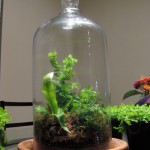

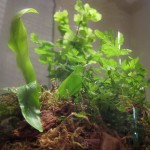
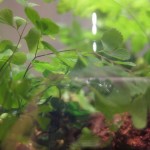
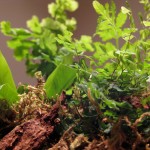
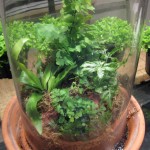
So pretty! I remember making terrariums in 4th grade, but we just stuffed dirt and such in the bottom of a jar; didn’t occur to me to turn the thing over, lol.
Hey Katie Lynn!
I read your line “cabinet of curiosities” style decor”, to mom and the girls, and we all had a good time reminiscing about your unique approach to decorating. Chloe joked that she wasn’t surprised that you had a cloche, she was surprised you only have one : ). We all miss you and love your blog. I am actually going to attempt this project in my new apt! Thanks for the idea, keep ’em coming.
Hi there! I just came across your post while searching for cloche terrariums. I am attempting to make a terrarium very much like your lovely one and had a couple questions I was hoping you might be able to answer. Most things I have read mention removing the lid of terrariums every now and then if the condensation gets to be too much. Have you had any problems with this and, if so, how did you remedy it since your terrarium has no lid? Are you able to remove the cloche without the soil falling apart or does it hold it’s shape sans cloche? Have you needed to water your plants at all since setting the terrarium up? Thank you!
Hi Angi! I did have to water the plants once since I originally set it up. This is because I kept them in their original plastic pots, so they can’t pull the moisture directly from the surrounding soil. I also used a terra cotta base, which does allow for some evaporation to take place. I decided that I like the look of the terra cotta base enough to contend with the watering that I need to do about every 4-5 weeks. The soil stays put pretty well because it is moist and the decorative moss tends to hold everything in place. I knew that I would need to open my terrarium every now and then, so I treated it like an “open” terrarium and not a “closed” one. The main difference between an open terrarium and a closed terrarium is the addition of two extra layers. If you want to build a “closed” terrarium, I would suggest building your layers as follows: gravel on the bottom for good drainage, activated charcoal (like that found in the aquarium section of a pet supply store, not the stuff you cook with), then the layers that I discuss above, the soil, mulch and decorative mosses. Then you’ll want to take the plants out of their pots. I wanted the flexibility to change the plants from time to time and I didn’t want them to grow too quickly, so I left them in their pots.
When I first set the terrarium up, I did get a lot of condensation and I continued to rotate it in indirect sunlight and it cleared up after a day or two. Keep in mind, that once your plants get used to the moist environment, leaving the cloche off (or lid open) for anything longer than 45 minutes can expose them to conditions that are too dry. Especially if you have delicate ferns like the Maidenhair varieties. If you are concerned about the level of condensation, it is better to leave the lid open for short periods of time (15-20 minutes) more often, rather than for a long period of time, less often.
I hope that helps! Feel free to post pictures of your final project on the katie: normal girl Facebook page, I’d love to see!
Hi! Well I’m all set to start on my first terrarium. I have everything I need. I’m wanting to make a “closed” one but I’m a little concerned about the paper ring thing. Will everything, including bottom layer of rocks stay together long enough for me to remove it? I’m worried about it falling apart.
I completely understand. I wasn’t sure if it would work when I first thought of it but it did! The layer of rocks seems to be shallow enough that the moist dirt on top holds them in place long enough to gently cut the paper ring off and put the top in place. I really think that it worked so well because the layers weren’t too deep. I actually did this project about two years ago and my little terrarium is still holding up quite nicely. Over time everything just seems to have grown together and I can easily remove the cloche for cleaning without the base falling apart. I’m sure it will go great for you! You’re welcome to post a pic or two on the Facebook page, I always enjoy seeing what people come up with!
Katie- thank you so much for the great advice and information! It is very helpful indeed! I will post a pic once I get my terrarium all set up.
Very cool! Terrariums are all the rage right now were I live, in fact my local garden center has been holding classed on how to make your own.
By the way, I strolled on over here from Susie’s blog party, great idea if you ask me. And, I think I’ve found a new blog to follow!
That is so cool, I’d been trying to find something like that around here. It just seems like fun to get together with a group and create tiny worlds under glass.
So glad you stopped by and I’m looking forward to following the dog mama adventures on your blog!
I love terrariums! They look like miniature fairylands.. Thanks for the step by step instructions. I will have to try one!
I hope you are meeting some new bloggers today!
excellent instructions!
Glad you liked it! I had a good time poking around your blog, thanks for stopping by!
Ferns are such beautiful plants. Like tiny magical forests.
Hi Katie. I had asked a question you about the paper ring working and I just wanted to tell you that I tried it and it worked great! I was a little worried about everything “falling” apart, but it worked really well. My problem now is that I have too much condensation in my closed terrarium. What did I do wrong? Other then that, I love my little rain forest. Hope you can help. Thanks, Jean
I’m so glad to hear that it worked for you! When you say too much condensation, are you referring to a light layer of fine condensation, kind of like fog? That can happen when you first put together a terrarium but it usually clears up over night. If it doesn’t, then I would leave it out of direct sunlight in a cool area for the day. That should clear it up. Let me know how it goes!
Thanks Katie for your quick response. My terrarium has been made for 5 or 6 days now and the condensation has never cleared up. I never had it in direct sunlight. Could it be something else? I’m going to put it totally away from any light source, like my bathroom and see how that works. Thanks again. I’ll let ya know how things are going. Bye….Jean